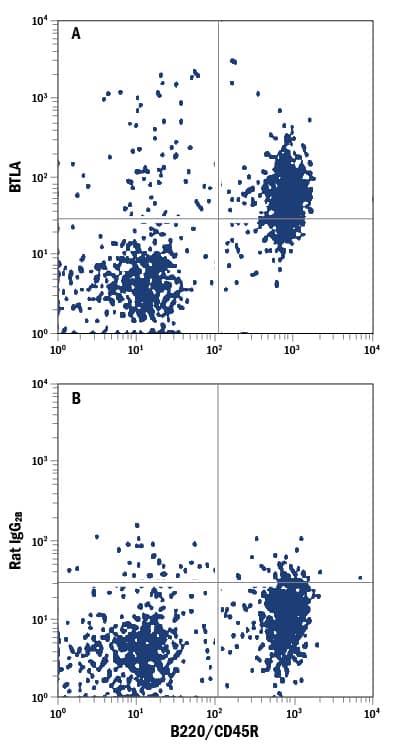Mouse BTLA Alexa Fluor® 488-conjugated Antibody
R&D Systems, part of Bio-Techne | Catalog # FAB7600G


Key Product Details
Species Reactivity
Applications
Label
Antibody Source
Product Specifications
Immunogen
Met1-Pro176
Accession # Q7TSA3
Specificity
Clonality
Host
Isotype
Scientific Data Images for Mouse BTLA Alexa Fluor® 488-conjugated Antibody
Detection of BTLA in Mouse Splenocytes by Flow Cytometry.
Mouse splenocytes were stained with Rat Anti-Mouse B220/CD45R APC-conjugated Monoclonal Antibody (Catalog # FAB1217A) and either (A) Rat Anti-Mouse BTLA Alexa Fluor® 488-conjugated Monoclonal Antibody (Catalog # FAB7600G) or (B) Rat IgG2BAlexa Fluor 488 Isotype Control (Catalog # IC013G). View our protocol for Staining Membrane-associated Proteins.Applications for Mouse BTLA Alexa Fluor® 488-conjugated Antibody
Flow Cytometry
Sample: Mouse splenocytes
Formulation, Preparation, and Storage
Purification
Formulation
Shipping
Stability & Storage
- 12 months from date of receipt, 2 to 8 °C as supplied.
Background: BTLA
B- and T-lymphocyte attenuator (BTLA; also known as CD272) is a 70 kDa, Ig-superfamily, type I transmembrane glycoprotein that is structurally similar to the CD28 family of T cell co-stimulatory or coinhibitory molecules (1-3). Unlike CD28 family members, however, the BTLA extracellular Ig domain is an I-type rather than a V-type domain, and BTLA does not form homodimers (4). BTLA also differs from CD28 family members through the interaction of its Ig domain with the TNF superfamily member HVEM (herpes virus entry mediator; also known as TNFSF14) rather than with B7 family ligands (5). BTLA is a coinhibitory molecule expressed on T cells, B cells and, depending on the mouse strain, macrophages, dendritic and NK cells (6). Expression is low in naïve T cells and increased during antigen-specific induction of anergy. In B cells, BTLA is highest when cells are mature and naïve (6). BTLA apparently limits T cell numbers, since deletion of BTLA results in overproduction of T cells, especially CD8+ memory T cells that are hyper-responsive to TCR crosslinking (7). The 305 amino acid (aa) BTLA contains a 29 aa signal sequence, a 153 aa extracellular domain (ECD), a 21 aa transmembrane sequence, and a 102 aa cytoplasmic domain. There are two ITIM motifs and three Tyr phosphorylation sites in the cytoplasmic tail that mediate inhibitory signaling (8, 9). The binding of the BTLA to HVEM does not preclude additional binding of a mammalian stimulatory HVEM ligand, either LIGHT or lymphotoxin-alpha to the complex (4). At least three alleles varying by up to ten extracellular amino acids occur in different mouse strains (6). The ECD of C57BL/6 BTLA shows 51%, 77% and 40% aa identity to that of human, rat and canine BTLA, respectively. A splice variant lacking the Ig domain, termed BTLAs, has been reported (3).
References
- Murphy, K. M. et al. (2006) Nat. Rev. Immunol. 6:671.
- Croft, M. (2005) Trends Immunol. 26:292.
- Watanabe, N. et al. (2003) Nat. Immunol. 4:670.
- Compaan, D. M. et al. (2005) J. Biol. Chem. 280:39553.
- Sedy, J. R. et al. (2005) Nat. Immunol. 6:90.
- Hurchla, M. A. et al. (2005) J. Immunol. 174:3377.
- Krieg, C. et al. (2007) Nat. Immunol. 8:162.
- Gavrieli, M. et al. (2003) Biochem. Biophys. Res. Commun. 312:1236.
- Chemnitz, J. M. et al. (2006) J. Immunol. 176:6603.
Long Name
Alternate Names
Gene Symbol
UniProt
Additional BTLA Products
Product Documents for Mouse BTLA Alexa Fluor® 488-conjugated Antibody
Product Specific Notices for Mouse BTLA Alexa Fluor® 488-conjugated Antibody
This product is provided under an agreement between Life Technologies Corporation and R&D Systems, Inc, and the manufacture, use, sale or import of this product is subject to one or more US patents and corresponding non-US equivalents, owned by Life Technologies Corporation and its affiliates. The purchase of this product conveys to the buyer the non-transferable right to use the purchased amount of the product and components of the product only in research conducted by the buyer (whether the buyer is an academic or for-profit entity). The sale of this product is expressly conditioned on the buyer not using the product or its components (1) in manufacturing; (2) to provide a service, information, or data to an unaffiliated third party for payment; (3) for therapeutic, diagnostic or prophylactic purposes; (4) to resell, sell, or otherwise transfer this product or its components to any third party, or for any other commercial purpose. Life Technologies Corporation will not assert a claim against the buyer of the infringement of the above patents based on the manufacture, use or sale of a commercial product developed in research by the buyer in which this product or its components was employed, provided that neither this product nor any of its components was used in the manufacture of such product. For information on purchasing a license to this product for purposes other than research, contact Life Technologies Corporation, Cell Analysis Business Unit, Business Development, 29851 Willow Creek Road, Eugene, OR 97402, Tel: (541) 465-8300. Fax: (541) 335-0354.
For research use only